
DATE 7 May – 17 May 2021
We are happy to bring good news! At CHI 2021, KAIST records a total of 22 full paper publications (with 7 Honorable Mention Awards), ranking 4th place in the number of publications out of all CHI 2021 participating institutions. Congratulations on the outstanding achievement!
KAIST CHI Statistics (2015-2021)
Year Number of Publications Rank
2015 9 14
2016 15 7
2017 7 26
2018 21 8
2019 13 11
2020 15 14
2021 22 4
Nation-wide (Korea) CHI Statistics (2015-2021)
Year Number of Publications Rank
2015 17 6
2016 20 6
2017 16 11
2018 30 6
2019 23 8
2020 29 7
2021 35 7
CHI 2021 Publications
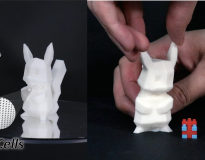
Designing Metamaterial Cells to Enrich Thermoforming 3D Printed Objects for Post-Print Modification
CHI'21, Honorable Mention
Donghyeon Ko, Jee Bin Yim, Yujin Lee, Jaehoon Pyun, Woohun Lee
In this paper, we present a metamaterial structure called thermoformable cells, TF-Cells, to enrich thermoforming for post-print modification. So far, thermoforming is limitedly applied for modifying a 3D printed object due to its low thermal conductivity. TF-Cells consists of beam arrays that affluently pass hot air and have high heat transference. Through heating the embedded TF-Cells of the printed object, users can modify not only the deeper area of the object surface but also its form factor. With a series of technical experiments, we investigated TF-Cells’ thermoformability, depending on their structure’s parameters, orientations, and heating conditions. Next, we present a series of compound cells consisting of TF-Cells and solid structure to adjust stiffness or reduce undesirable shape deformation. Adapting the results from the experiments, we built a simple tool for embedding TF-Cells into a 3D model. Using the tool, we implemented examples under contexts of mechanical fitting, ergonomic fitting, and aesthetic tuning.
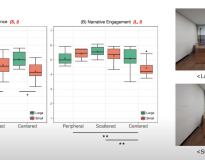
A User-Oriented Approach to Space-Adaptive Augmentation: The Effects of Spatial Affordance on Narrative Experience in an Augmented Reality Detective Game
CHI'21, Honorable Mention
Jae-eun Shin, Boram Yoon, Dooyoung Kim, Woontack Woo
Space-adaptive algorithms aim to effectively align the virtual with the real to provide immersive user experiences for Augmented Reality(AR) content across various physical spaces. While such measures are reliant on real spatial features, efforts to understand those features from the user’s perspective and reflect them in designing adaptive augmented spaces have been lacking. For this, we compared factors of narrative experience in six spatial conditions during the gameplay of Fragments, a space-adaptive AR detective game. Configured by size and furniture layout, each condition afforded disparate degrees of traversability and visibility. Results show that whereas centered furniture clusters are suitable for higher presence in sufficiently large rooms, the same layout leads to lower narrative engagement. Based on our findings, we suggest guidelines that can enhance the effects of space adaptivity by considering how users perceive and navigate augmented space generated from different physical environments.
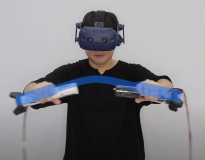
GamesBond: Bimanual Haptic Illusion of Physically Connected Objects for Immersive VR Using Grip Deformation
CHI'21, Honorable Mention
Neung Ryu, Hye-Young Jo, Michel Pahud, Mike Sinclair, Andrea Bianchi
Virtual Reality experiences, such as games and simulations, typically support the usage of bimanual controllers to interact with virtual objects. To recreate the haptic sensation of holding objects of various shapes and behaviors with both hands, previous researchers have used mechanical linkages between the controllers that render adjustable stiffness. However, the linkage cannot quickly adapt to simulate dynamic objects, nor it can be removed to support free movements. This paper introduces GamesBond, a pair of 4-DoF controllers without physical linkage but capable to create the illusion of being connected as a single device, forming a virtual bond. The two controllers work together by dynamically displaying and physically rendering deformations of hand grips, and so allowing users to perceive a single connected object between the hands, such as a jumping rope. With a user study and various applications we show that GamesBond increases the realism, immersion, and enjoyment of bimanual interaction.
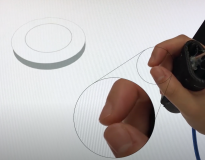
AtaTouch: Robust Finger Pinch Detection for a VR Controller Using RF Return Loss
CHI'21, Honorable Mention
Daehwa Kim, Keunwoo Park, Geehyuk Lee
Handheld controllers are an essential part of VR systems. Modern sensing techniques enable them to track users’ finger movements to support natural interaction using hands. The sensing techniques, however, often fail to precisely determine whether two fingertips touch each other, which is important for the robust detection of a pinch gesture. To address this problem, we propose AtaTouch, which is a novel, robust sensing technique for detecting the closure of a finger pinch. It utilizes a change in the coupled impedance of an antenna and human fingers when the thumb and finger form a loop. We implemented a prototype controller in which AtaTouch detects the finger pinch of the grabbing hand. A user test with the prototype showed a finger-touch detection accuracy of 96.4%. Another user test with the scenarios of moving virtual blocks demonstrated low object-drop rate (2.75%) and false-pinch rate (4.40%). The results and feedback from the participants support the robustness and sensitivity of AtaTouch.
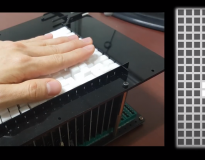
ThroughHand: 2D Tactile Interaction to Simultaneously Recognize and Touch Multiple Objects
CHI'21, Honorable Mention
Jingun Jung, Sunmin Son, Sangyoon Lee, Yeonsu Kim, Geehyuk Lee
Users with visual impairments find it difficult to enjoy real-time 2D interactive applications on the touchscreen. Touchscreen applications such as sports games often require simultaneous recognition of and interaction with multiple moving targets through vision. To mitigate this issue, we propose ThroughHand, a novel tactile interaction that enables users with visual impairments to interact with multiple dynamic objects in real time. We designed the ThroughHand interaction to utilize the potential of the human tactile sense that spatially registers both sides of the hand with respect to each other. ThroughHand allows interaction with multiple objects by enabling users to perceive the objects using the palm while providing a touch input space on the back of the same hand. A user study verified that ThroughHand enables users to locate stimuli on the palm with a margin of error of approximately 13 mm and effectively provides a real-time 2D interaction experience for users with visual impairments.
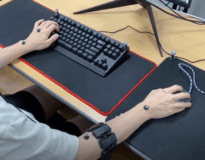
Secrets of Gosu: Understanding Physical Combat Skills of Professional Players in First-Person Shooters
CHI'21, Honorable Mention
Eunji Park, Sangyoon Lee, Auejin Ham, Minyeop Choi, Sunjun Kim, Byungjoo Lee
In first-person shooters (FPS), professional players (a.k.a., Gosu) outperform amateur players. The secrets behind the performance of professional FPS players have been debated in online communities with many conjectures; however, attempts of scientific verification have been limited. We addressed this conundrum through a data-collection study of the gameplay of eight professional and eight amateur players in the commercial FPS Counter-Strike: Global Offensive. The collected data cover behavioral data from six sensors (motion capture, eye tracker, mouse, keyboard, electromyography armband, and pulse sensor) and in-game data (player data and event logs). We examined conjectures in four categories: aiming, character movement, physicality, and device and settings. Only 6 out of 13 conjectures were supported with statistically sufficient evidence.
A Simulation Model of Intermittently Controlled Point-and-Click Behaviour
CHI'21, Honorable Mention
Do Seungwon, Minsuk Chang, Byungjoo Lee
We present a novel simulation model of point-and-click behaviour that is applicable both when a target is stationary or moving. To enable more realistic simulation than existing models, the model proposed in this study takes into account key features of the user and the external environment, such as intermittent motor control, click decision-making, visual perception, upper limb kinematics and the effect of input device. The simulated user’s point-and-click behaviour is formulated as a Markov decision process (MDP), and the user’s policy of action is optimised through deep reinforcement learning. As a result, our model successfully and accurately reproduced the trial completion time, distribution of click endpoints, and cursor trajectories of real users. Through an ablation study, we showed how the simulation results change when the model’s sub-modules are individually removed. The implemented model and dataset are publicly available.
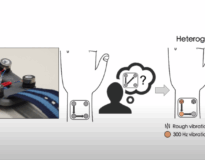
Heterogeneous Stroke: Using Unique Vibration Cues to Improve the Wrist-Worn Spatiotemporal Tactile Display
CHI'21
Taejun Kim, Youngbo Aram Shim, Geehyuk Lee
Beyond a simple notification of incoming calls or messages, more complex information such as alphabets and digits can be delivered through spatiotemporal tactile patterns (STPs) on a wrist-worn tactile display (WTD) with multiple tactors. However, owing to the limited skin area and spatial acuity of the wrist, frequent confusions occur between closely located tactors, resulting in a low recognition accuracy. Furthermore, the accuracies reported in previous studies have mostly been measured for a specific posture and could further decrease with free arm postures in real life. Herein, we present Heterogeneous Stroke, a design concept for improving the recognition accuracy of STPs on a WTD. By assigning unique vibrotactile stimuli to each tactor, the confusion between tactors can be reduced. Through our implementation of Heterogeneous Stroke, the alphanumeric characters could be delivered with high accuracy (93.8% for 26 alphabets and 92.4% for 10 digits) across different arm postures.

RubySlippers: Supporting Content-based Voice Navigation for How-to Videos
CHI'21
Minsuk Chang, Mina Huh, Juho Kim
Directly manipulating the timeline, such as scrubbing for thumbnails, is the standard way of controlling how-to videos. However, when how-to videos involve physical activities, people inconveniently alternate between controlling the video and performing the tasks. Adopting a voice user interface allows people to control the video with voice while performing the tasks with hands. However, naively translating timeline manipulation into voice user interfaces (VUI) results in temporal referencing (e.g. “rewind 20 seconds’‘), which requires a different mental model for navigation and thereby limiting users’ ability to peek into the content. We present RubySlippers, a system that supports efficient content-based voice navigation through keyword-based queries. Our computational pipeline automatically detects referenceable elements in the video, and finds the video segmentation that minimizes the number of needed navigational commands. Our evaluation (N=12) shows that participants could perform three representative navigation tasks with fewer commands and less frustration using RubySlippers than the conventional voice-enabled video interface.

Personalizing Ambience and Illusionary Presence: How People Use “Study with me” Videos to Create Effective Studying Environments
CHI'21
Yoonjoo Lee, John Joon Young Chung, Jean Y. Song, Minsuk Chang, Juho Kim
“Study with me” videos contain footage of people studying for hours, in which social components like conversations or informational content like instructions are absent. Recently, they became increasingly popular on video-sharing platforms. This paper provides the first broad look into what “study with me” videos are and how people use them. We analyzed 30 “study with me” videos and conducted 12 interviews with their viewers to understand their motivation and viewing practices. We identified a three-factor model that explains the mechanism for shaping a satisfactory studying experience in general. One of the factors, a well-suited ambience, was difficult to achieve because of two common challenges: external conditions that prevent studying in study-friendly places and extra cost needed to create a personally desired ambience. We found that the viewers used “study with me” videos to create a personalized ambience at a lower cost, to find controllable peer pressure, and to get emotional support. These findings suggest that the viewers self-regulate their learning through watching “study with me” videos to improve efficiency even when studying alone at home.

Sticky Goals: Understanding Goal Commitments for Behavioral Changes in the Wild
CHI’21
Hyunsoo Lee, Auk Ki, Hwajung Hong, Uichin Lee
A commitment device, an attempt to bind oneself for a successful goal achievement, has been used as an effective strategy to promote behavior change. However, little is known about how commitment devices are used in the wild, and what aspects of commitment devices are related to goal achievements. In this paper, we explore a large-scale dataset from stickK, an online behavior change support system that provides both financial and social commitments. We characterize the patterns of behavior change goals (e.g., topics and commitment setting) and then perform a series of multilevel regression analyses on goal achievements. Our results reveal that successful goal achievements are largely dependent on the configuration of financial and social commitment devices, and a mixed commitment setting is considered beneficial. We discuss how our findings could inform the design of effective commitment devices, and how large-scale data can be leveraged to support data-driven goal elicitation and customization.
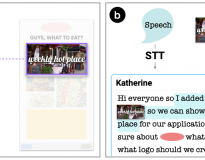
Winder: Linking Speech and Visual Objects to Support Communication in Asynchronous Collaboration
CHI'21
Tae Soo Kim, Seungsu Kim, Yoonseo Choi, Juho Kim
Team members commonly collaborate on visual documents remotely and asynchronously. Particularly, students are frequently restricted to this setting as they often do not share work schedules or physical workspaces. As communication in this setting has delays and limits the main modality to text, members exert more effort to reference document objects and understand others’ intentions. We propose Winder, a Figma plugin that addresses these challenges through linked tapes—multimodal comments of clicks and voice. Bidirectional links between the clicked-on objects and voice recordings facilitate understanding tapes: selecting objects retrieves relevant recordings, and playing recordings highlights related objects. By periodically prompting users to produce tapes, Winder preemptively obtains information to satisfy potential communication needs. Through a five-day study with eight teams of three, we evaluated the system’s impact on teams asynchronously designing graphical user interfaces. Our findings revealed that producing linked tapes could be as lightweight as face-to-face (F2F) interactions while transmitting intentions more precisely than text. Furthermore, with preempted tapes, teammates coordinated tasks and invited members to build on each others’ work.
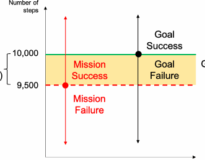
"Good Enough!": Flexible Goal Achievement with Margin-based Outcome Evaluation
CHI'21
Gyuwon Jung, Jio Oh, Youjin Jung, Juho Sun, Ha-Kyung Kong, Uichin Lee
Traditional goal setting simply assumes a binary outcome for goal evaluation. This binary judgment does not consider a user’s effort, which may demotivate the user. This work explores the possibility of mitigating this negative impact with a slight modification on the goal evaluation criterion, by introducing a ‘margin’ that is widely used for quality control in the manufacturing fields. A margin represents a range near the goal where the user’s outcome will be regarded as ‘good enough’ even if the user fails to reach it. We explore users’ perceptions and behaviors through a large-scale survey study and a small-scale field experiment using a coaching system to promote physical activity. Our results provide positive evidence on the margin, such as lowering the burden of goal achievement and increasing motivation to make attempts. We discuss practical design implications on margin-enabled goal setting and evaluation for behavioral change support systems.

GoldenTime: Exploring System-Driven Timeboxing and Micro-Financial Incentives for Self-Regulated Phone Use
CHI'21
Joonyoung Park, Hyunsoo Lee, Sangkeun Park, Kyong-Mee Chung, Uichin Lee
User-driven intervention tools such as self-tracking help users to self-regulate problematic smartphone usage. These tools basically assume active user engagement, but prior studies warned a lack of user engagement over time. This paper proposes GoldenTime, a mobile app that promotes self-regulated usage behavior via system-driven proactive timeboxing and micro-financial incentives framed as gain or loss for behavioral reinforcement. We conducted a large-scale user study (n = 210) to explore how our proactive timeboxing and micro-financial incentives influence users’ smartphone usage behaviors. Our findings show that GoldenTime’s timeboxing based micro-financial incentives are effective in self-regulating smartphone usage, and incentive framing has a significant impact on user behavior. We provide practical design guidelines for persuasive technology design related to promoting digital wellbeing.
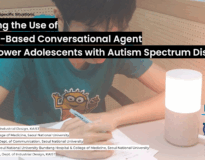
Exploring the Use of a Voice-based Conversational Agent to Empower Adolescents with Autism Spectrum Disorder
CHI'21
Inha Cha, Sung-In Kim, Hwajung Hong, Heejeong Yoo, and Youn-kyung Lim
Voice-based Conversational Agents (VCA) have served as personal assistants that support individuals with special needs. Adolescents with Autism Spectrum Disorder (ASD) may also benefit from VCAs to deal with their everyday needs and challenges, ranging from self-care to social communications. In this study, we explored how VCAs could encourage adolescents with ASD in navigating various aspects of their daily lives through the two-week use of VCAs and a series of participatory design workshops. Our findings demonstrated that VCAs could be an engaging, empowering, emancipating tool that supports adolescents with ASD to address their needs, personalities, and expectations, such as promoting self-care skills, regulating negative emotions, and practicing conversational skills. We propose implications of using off-the-shelf technologies as a personal assistant to ASD users in Assistive Technology design. We suggest design implications for promoting positive opportunities while mitigating the remaining challenges of VCAs for adolescents with ASD.
MomentMeld: AI-augmented Mobile Photographic Memento towards Mutually Stimulatory Inter-generational Interaction
CHI'21
Bumsoo Kang, Seungwoo Kang, Inseok Hwang
ToonNote: Improving Communication in Computational Notebooks Using Interactive Data Comics
CHI'21
DaYe Kang, Tony Ho, Nicolai Marquardt, Bilge Mutlu, Andrea Bianchi
Elevate: A Walkable Pin-Array for Large Shape-Changing Terrains
CHI'21
Seungwoo Je, Hyunseung Lim, Kongpyung Moon, Shan-Yuan Teng, Jas Brooks, Pedro Lopes, Andrea Bianchi
Human Perceptions on Moral Responsibility of AI: A Case Study in AI-Assisted Bail Decision-Making
CHI'21
Gabriel Lima, Nina Grgić-Hlača, Meeyoung Cha
Virtual Camera Layout Generation using a Reference Video
CHI'21
Jung Eun Yoo, Kwanggyoon Seo, Sanghun Park, Jaedong Kim, Dawon Lee, Junyong Noh
Late Breaking Work
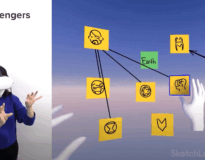
Post-Post-it: A Spatial Ideation System in VR for Overcoming Limitations of Physical Post-it Notes
Extended Abstracts of the 2021 CHI Conference on Human Factors in Computing Systems (LBW)
Joon Hyub Lee, Donghyeok Ma, Haena Cho, Seok-Hyung Bae
Post-it notes are great problem-solving tools. However, physical Post-it notes have limitations: surfaces for attaching them can run out; rearranging them can be labor-intensive; documenting and storing them can be cumbersome. We present Post-Post-it, a novel VR interaction system that overcomes these physical limitations. We derived design requirements from a formative study involving a problem-solving meeting using Post-it notes. Then, through physical prototyping, using physical materials such as Post-it notes, transparent acrylic panels, and masking tape, we designed a set of lifelike VR interactions based on hand gestures that the user can perform easily and intuitively. With our system, the user can create and place Post-it notes in an immersive space that is large enough to ideate freely, quickly move, copy, or delete many Post-it notes at once, and easily manage the results.
I Can't Talk Now: Speaking with Voice Output Communication Aid Using Text-to-Speech Synthesis During Multiparty Video Conference
Extended Abstracts of the 2021 CHI Conference on Human Factors in Computing Systems (LBW)
I want more than 👍 User-generated icons for Better Video-mediated Communications on the Collaborative Design Process
Extended Abstracts of the 2021 CHI Conference on Human Factors in Computing Systems (LBW)
How the Death-themed Game Spiritfarer Can Help Players Cope with the Loss of a Loved One
Extended Abstracts of the 2021 CHI Conference on Human Factors in Computing Systems (LBW)
“I Don’t Know Exactly but I Know a Little”: Exploring Better Responses of Conversational Agents with Insufficient Information
Extended Abstracts of the 2021 CHI Conference on Human Factors in Computing Systems (LBW)
Bubble Coloring to Visualize the Speech Emotion
Extended Abstracts of the 2021 CHI Conference on Human Factors in Computing Systems (LBW)
Guideline-Based Evaluation and Design Opportunities for Mobile Video-based Learning
Extended Abstracts of the 2021 CHI Conference on Human Factors in Computing Systems (LBW)
Jeongyeon Kim, Juho Kim
Workshops & Symposia
Challenges in Devising Resources for Ethics: What Should We Consider When Designing Toolkits to Tackle AI Ethical Issues for Practitioners?
CHI 2021 (The ACM CHI Conference on Human Factors in Computing Systems 2021) Workshop on Co-designing Ethics.
Inha Cha and Youn-kyung Lim
Artificial Intelligence (AI) technologies become interwoven in our daily contexts with various services and products, and discussions on AI’s social impact are actively being held. As awareness on the social impact of AI technology increased, studies focusing on algorithmic bias and its harm have gained attention, as have the efforts to mitigate social bias. One way to solve this problem is to support and guide the practitioners who design the technologies. Therefore, various toolkits and methods, including checklists or open-source software, to detect algorithmic bias, games, and activity-based approaches have been devised to support practitioners. This paper proposes pros and cons according to toolkits’ characteristics based on the existing approaches. We want to discuss what we have to consider before designing toolkits to tackle AI ethics by examining the existing toolkits.
